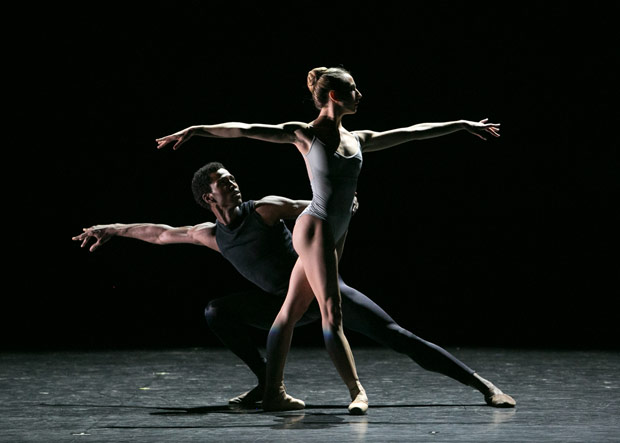
© Erin Baiano. (Click image for larger version)
Vail Dance Festival: ReMix NYC
3 Nov: Apollo, Divertimento Brillante, Fandango, This Bitter Earth, Élégie, 1-2-3-4-5-6, A Jookin’ Jam Session
4 Nov: Apollo, pdd from The Leaves are Fading, Lamentation, Fandango, A Jookin’ Jam Session
★★★★✰
New York, City Center
3, 4 November 2016
vaildance.org
www.nycitycenter.org
Rocky Mountain High
For years, New Yorkers have been getting reports about the Vail International Dance Festival, this little haven of dance in the Rocky Mountains where dancers go to try new things. Ballet dancers dip their feet in modern dance and vice versa, hip hop artists collaborate with classical musicians, new works are made. This yearly summer meetup is run by Damian Woetzel, a former leading dancer of the New York City Ballet and entrepreneurial spirit. This week, a sampling of these experiments has found its way to New York, repackaged as the Vail Dance Festival: ReMix NYC. It runs at City Center through Nov. 6.
After watching two of the four programs, a few things stand out. Firstly, it is clear that this is no simple gala, despite the format; there is a strong personal esthetic and philosophy at work behind the programs. Secondly, the level of the music-making is very high; I hadn’t realized how central this was to the whole enterprise. The evenings have included performances by the Catalyst Quartet, the FLUX Quartet, Yo Yo Ma and members of the Silk Road Ensemble, the excellent pianist Cameron Grant, and superior jazz vocalist Kate Davis. And finally: a common sense of purpose. These dancers, from different companies, are learning from each other, and growing in the process.
Both nights included performances of George Balanchine’s Apollo. This was to have been Herman Cornejo’s New York début in this role. But Cornejo is injured, and has been replaced by Robert Fairchild of New York City Ballet. Though Fairchild has danced it before, he has never performed the full version, which begins with Leto giving birth to Apollo, and ends with the god ascending Mount Parnassus (a staircase leading to a platform), followed by the muses Terpsichore, Calliope and Polyhymnia. Balanchine later cut both the beginning and the end; the truncated version is now danced at New York City Ballet, where Fairchild is a principal dancer.

© Erin Baiano. (Click image for larger version)
On both nights, the role of Terspichore was danced by Tiler Peck, a City Ballet colleague – and his wife – and Calliope was Isabella Boylston, of American Ballet Theatre (ABT). Polyhimnia was danced by Misa Kuranaga of Boston Ballet on Nov. 3rd, and by Devon Teuscher of ABT on the 4th. The second performance was tighter all around, but both were remarkably vivid. It is a great pleasure to see this ballet in a smaller theatre, where one can really experience its details. This version, far more theatrical, is full of them. Fairchild dances the ballet with a roughness and sense of discovery; at the beginning he is very much a young dolt testing his powers, sometimes stumbling and falling, and only gradually growing into his godly poise. Tiler Peck’s Terpsichore is luxuriant, with just a touch of flirtatiousness. As always, her musicality is astonishing. Her dancing lacks freshness, though; everything, even the “stumbles” built into her solo, feels a little bit too calculated.
Even so, the Apollo-Terpsichore pas de deux was a highlight; in the famous “swimming” lift, Fairchild placed her high on his shoulders and neck, so that she appeared to float weightlessly above him, gliding among the stars. Both casts were strong, but Isabella Boylston made a particular impression as Calliope, muse of poetry. When she wrote on her scroll, you could almost imagine the poetry on the page; when she opened her mouth to “sing” out her words, you could practically hear them.
The first program included a tap interlude, led by the virtuoso tapper (and tap innovator) Michelle Dorrance, joined by Robert Fairchild, who held his own. (Fairchild studied tap as a kid). Two additional dancers joined in, each doing his or her own thing: Melissa Toogood, formerly of Merce Cunningham’s troupe, and the Memphis jooker Lil Buck. The piece, entitled 1-2-3-4-5-6, was held together by a rhythmic pattern from Steve Reich’s Clapping Music, which ricocheted from Dorrance’s feet to her hands and the dancers’ bodies. This was a slight piece, more an experiment than a real work, appealing mainly as an example of the open, playful encounters that seem to flourish at Vail.
Fairchild returned yet again to perform the “Divertimento Brillante” section from Balanchine’s 1967 Glinkiana, with Tiler Peck. Here, Peck’s polish, the wondrous control and finesse of her phrasing, was dazzling. I was particularly struck by what looked like a slow motion pas de chat at the end of her solo. How does she do it? Then followed a wonderful solo, Fandango, created in 2010 by Alexei Ratmansky for Wendy Whelan, and danced here by Sara Mearns, of New York City Ballet. I can’t think of two more unalike performers. But after seeing Mearns in it, it’s hard to imagine the solo danced by anyone else. It perfectly suits her fiery but tongue-in-cheek stage manner, her wild jumps, her forceful attack, and her broad, expressive back. The choreography, set to a Spanish-flavored quintet by Luigi Boccherini, looks almost improvised. Mearns walks, flirts with the musicians, even claps along with their rhythms like a flamenco dancer. And then, abruptly, she launches into scrolling phrases, twisting and bending her upper body, slicing through the air in whip-like jumps, playfully scrolling her wrists, tapping the floor with her points.
Another work created at Vail for Whelan, This Bitter Earth, returned, now danced by Isabella Boylston and Calvin Royal of ABT. When Whelan danced it, in her last seasons, this pas de deux by Christopher Wheeldon felt like a portrait of a woman taking her leave. The words of the Dinah Washington song to which it is set felt particularly poignant: “Today you’re young, too soon, you’re old.” (Here at City Center the song is eloquently delivered by Kate Davis.) Sometimes, it was hard to watch. Boylston, at a very different point in her career, has remade it in her own image: stylish, un-confessional, fluid, grandly-shaped, and a little bit remote. (The male part is almost invisible.) It’s not a great pas de deux, but with live music, it does cast a certain spell.
And, speaking of spells… Carla Körbes, who retired from Pacific Northwest Ballet last year but has continued to dance for Woetzel, performed the solo Élégie, made just months before Balanchine’s death. The original interpreter was Suzanne Farrell; in her memoir, Farrell writes that performing it felt like dancing at his funeral. As a violist plays Stravinsky’s 1944 Élégie, the dancer kneels. She looks haunted; she draws her hands across her face and covers her eyes, opens her palms as if to read something there, and, once she rises, seems to teeter at the edge of an abyss. As it draws to a close, she turns away, arching her back like the ballerina at the end of Serenade, to contemplate infinity. It is a very spooky ballet, and Körbes dances it with great simplicity and directness, a perfectly calibrated, resonant performance. The same was true of Martha Graham’s Lamentation, which she performed on the second program of the festival in the place of of Élégie. It’s difficult for ballet dancers to look genuine in Graham, but she pulled it off.
On Program 2, This Bitter Earth was replaced by a pas de deux from Antony Tudor’s The Leaves are Fading. The music, an excerpt from Dvorak’s The Cypresses, was played by a quartet onstage – far superior to the usual orchestration. Tiler Peck was paired with ABT’s Cory Stearns, perhaps the least satisfying matchup of the two evenings. The duet is all about vulnerability and the style doesn’t really suit Peck; she’s too dynamic, not vulnerable or open enough. Cory Stearns was not in good form; his dancing lacked incisiveness and clarity. Their partnership didn’t flourish.
Both evenings closed with a medley created for the Memphis Jookers Lil Buck and Ron “Prime Tyme” Myles. (Jookin’ is a bouncy, seductive derivation of hip hop that originated in the city of Memphis.) The “band” consisted of members of the Silk Road Ensemble, including the ever-enthusiastic Yo Yo Ma. Everyone had a chance to shine. Wu Tong sang a Chinese ode, Sandeep Das improvised on the tabla, Cristina Pato pranced around gleefully and played the Galician gaita (a kind of bagpipe). Ma played Bach. Lil Buck and Myles gamely joined in, criss-crossing the stage with stitch-like bourrée steps on the points of their sneakers, unleashing amazing rippling effects that passed through their bodies like electric currents, gliding weightlessly through space like lithe astronauts, or tilting back until their heads practically touched the ground. They are both expressive performers, and highly musical.

© Erin Baiano. (Click image for larger version)
This was the festival’s big globalist gesture. The idea of inclusion, and of participation – of meeting the audience halfway – is a big part of the Vail ethos. A Jookin’ Jam Session is one of Woetzel’s mashups: big-hearted, a little hokey, rambling. But fun – everyone onstage seemed to be having a good time.












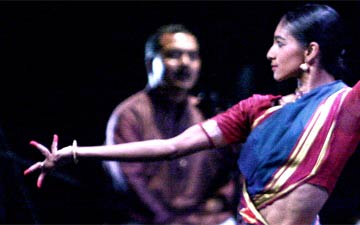

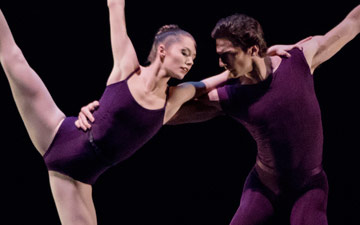
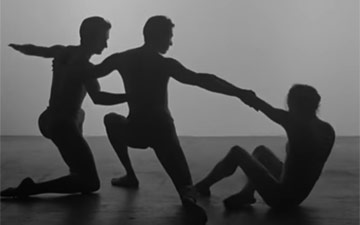
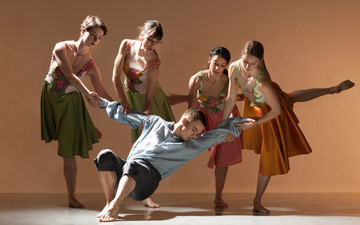
You must be logged in to post a comment.